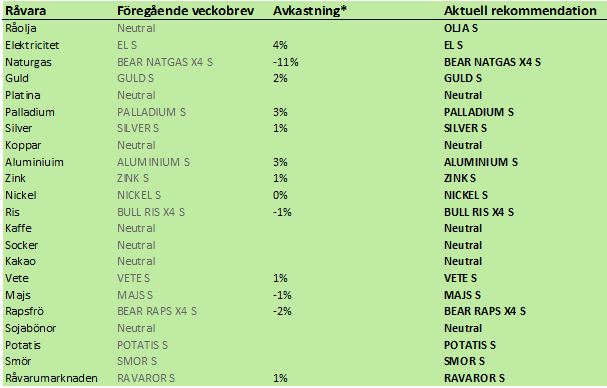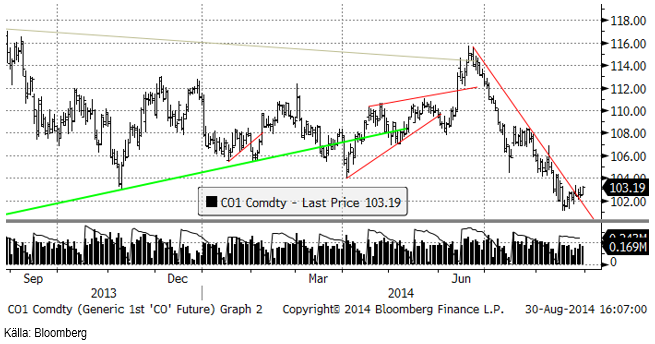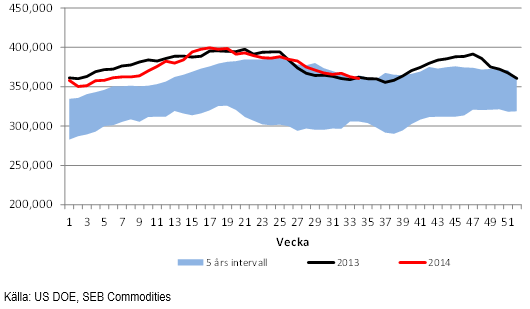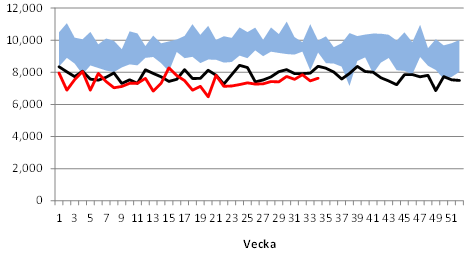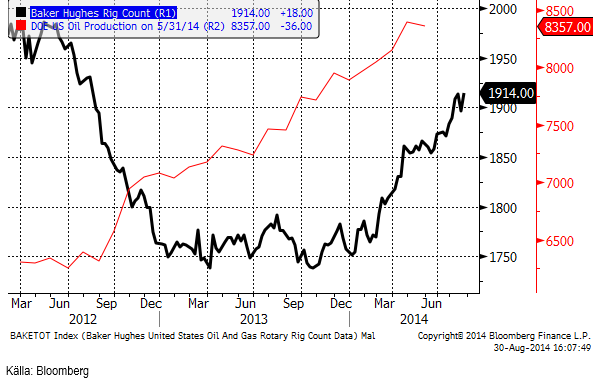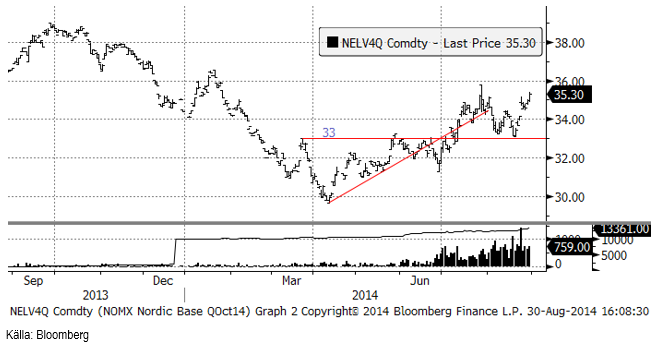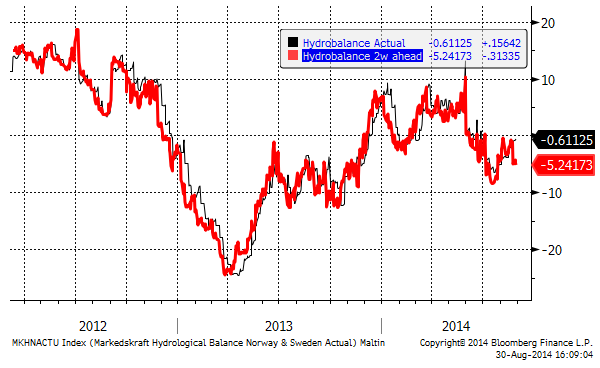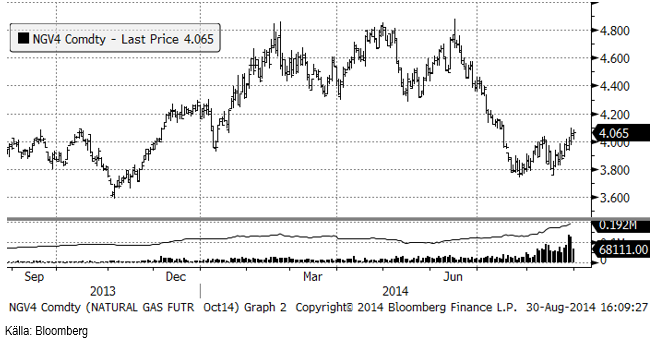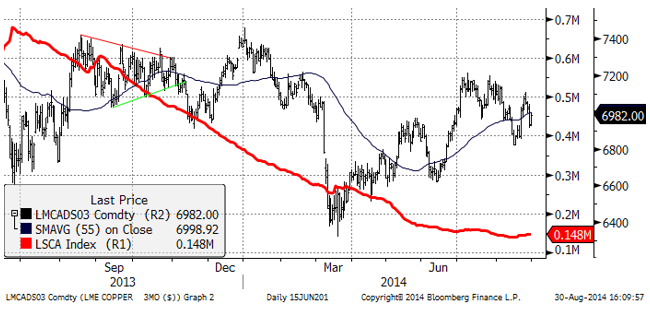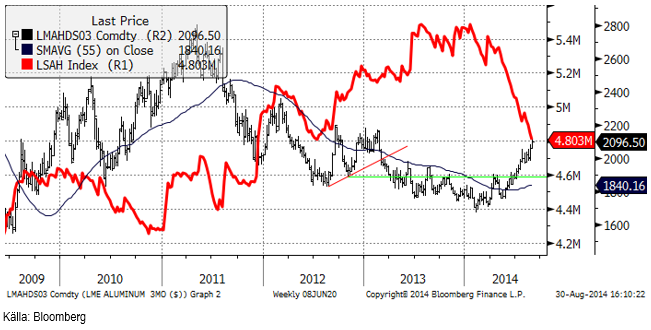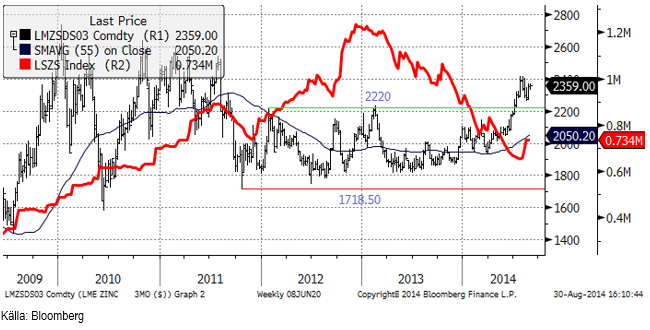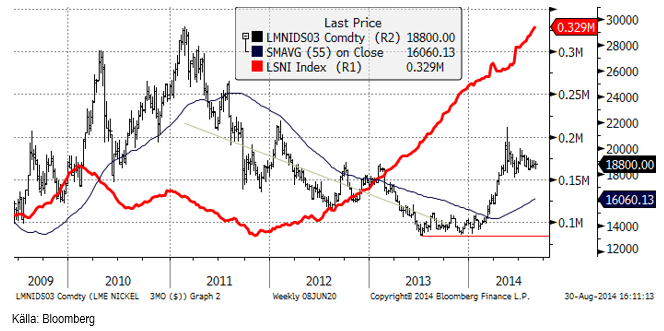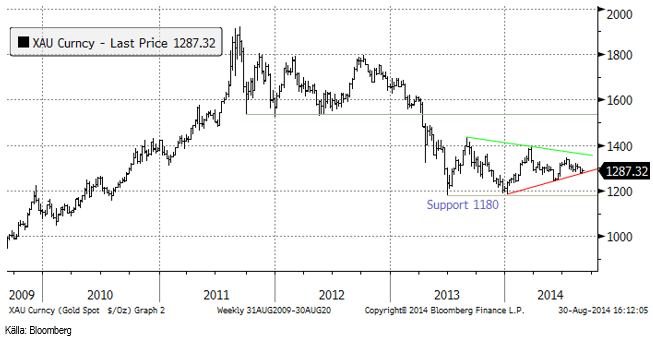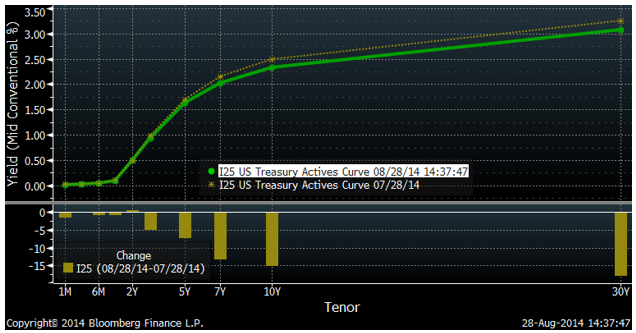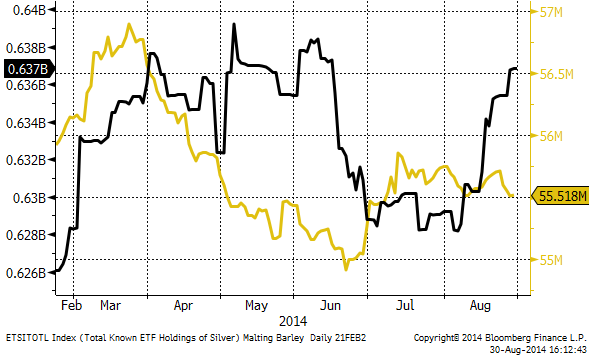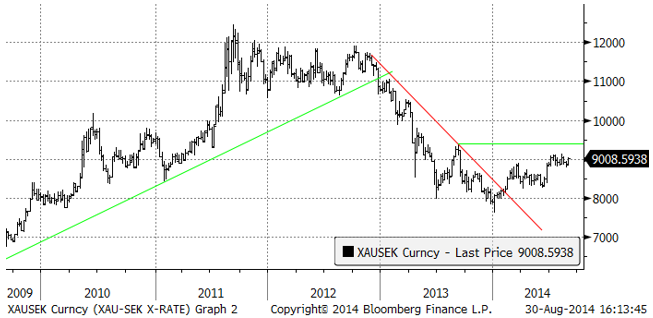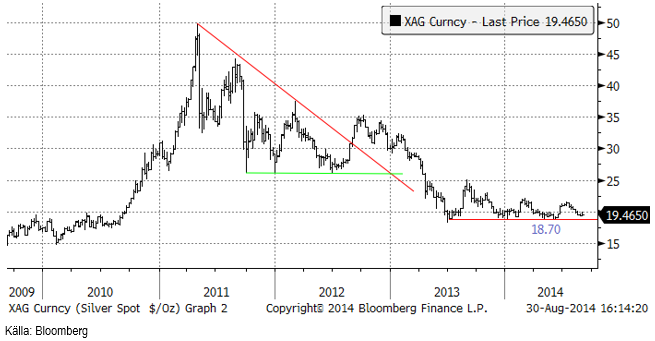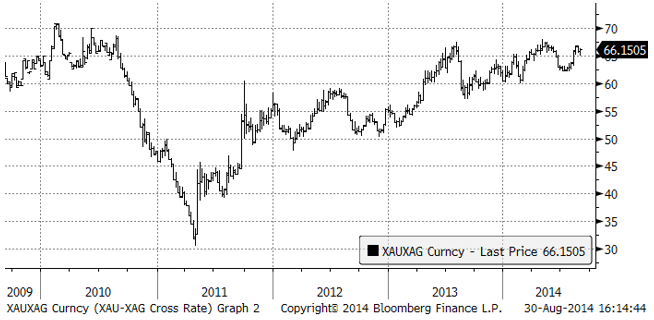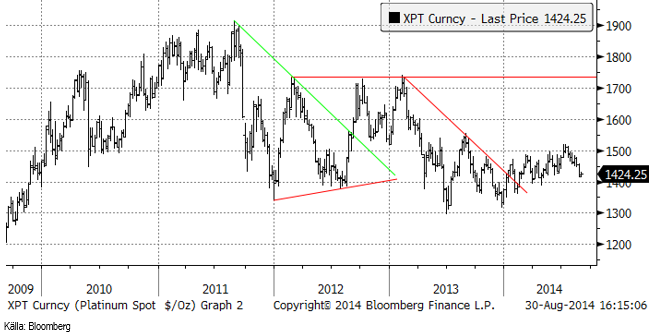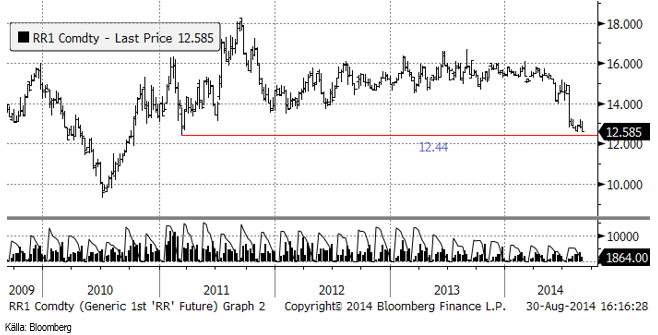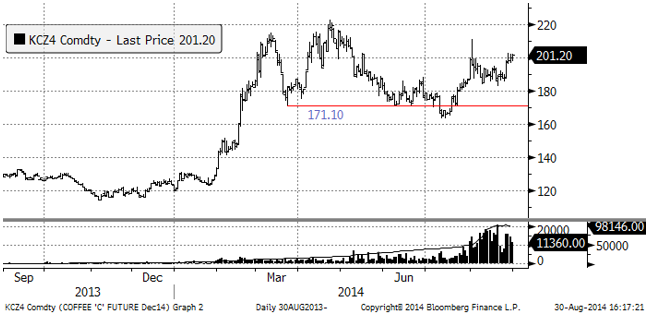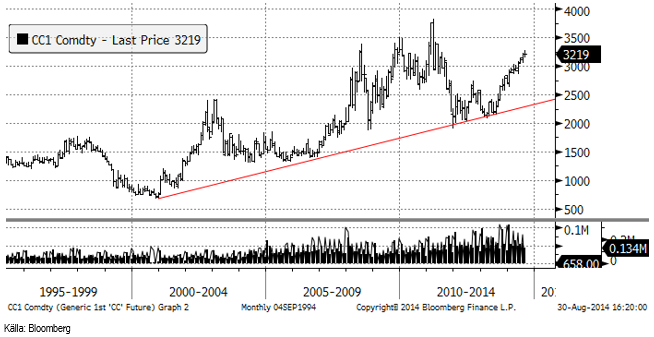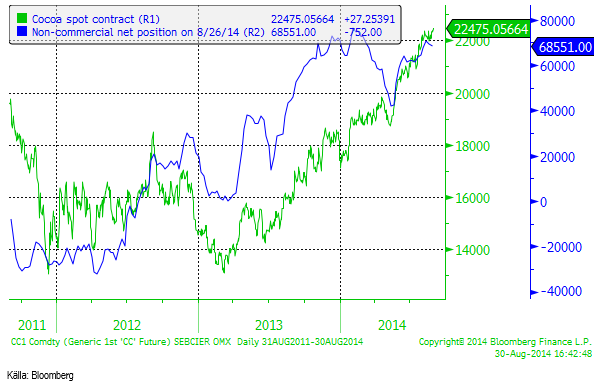Analys
SEB – Råvarukommentarer, 1 september 2014

Rekommendationer
Kort sammanfattning
Pga tilltagande geopolitisk oro tror vi att ädelmetaller och olja är bra att vara köpt på råvarumarknaden. Det finns ingen uppenbar råvara att vara kort den här veckan. SILVER S och OLJA S är alltså de rekommendationer vi vill lyfta fram.
Råolja – Brent
Oljepriset har brutit motståndet för den nedgång som varit sedan juni. Vi tror att det finns potential för uppsida och det motiveras bland annat av att OPEC har producerat maximalt och det finns en viss sårbarhet med ISIS som motor i MENA. Libyen känns också skakigt då t ex den amerikanska ambassaden i Tripoli intogs i helgen. Slutligen har vi Ryssland/Ukraina-krisen och vinter på norra halvklotet på väg.
Råoljelagren i USA sjönk 2 mbbl till 360.5 mbbl. Nu är lagernivån faktiskt 1.5 mbbl lägre än samma vecka förra året.
Importen av olja ökade 0.2 mbbl i veckans rapport från DOE, men ligger 0.7 mbbl under förra årets nivå samma vecka. Man brukar se en ökning av importen under juni, juli och augusti och en topp i alldeles i slutet av augusti. Under september, oktober, november och december, faktiskt ända fram till mitten av mars, minskar importen successivt. Det är möjligt att USA:s veckovisa import når ner till 6 mbbl någon gång under den här perioden. Det var väldigt nära den nivån i mitten av maj i år.
Nedan ser vi ett diagram på antalet oljeriggar i USA, enligt Baker Hughes statistik (svart) och USA:s oljeproduktion enligt US DOE på 8.357 mbpd. Antalet borr-riggar steg återigen över 1900.
Vi rekommenderar alltså på kort sikt köp i olja, t ex via OLJA S.
Elektricitet
China minskar ytterligare på koleldad elkraft. Samtidigt kämpar 50% av kolgruvorna i världen med lönsamhetsproblem. Terminerna för kol i Europa har fallit till 80 dollar per ton för kalenderår 2015. I Euro-termer har kolpriset varit stabilt, men euron har varit svag då den svaga tillväxten i EU tynger. Ukrainakrisen tynger lite extra, men vintern är i antågande och Ukrainakrisen skapar också oro för energitillförseln.
På kort sikt tror vi att elpriset faktiskt testar och troligtvis bryter motståndsnivåerna.
Hydrologisk balans har enligt 2-veckors prognosen försvagats.
Vi rekommenderar köp av EL S om priset kommer ner lite.
Naturgas
Naturgaspriset har inte alls gått åt vårt håll den senaste veckan, men rekylen uppåt borde stöta på patrull vid 4.20, som är ett tekniskt motstånd. Med viss tvekan håller vi fast vid vår investering i t ex BEAR NATGAS X4 S.
Koppar
Kopparmarknaden ägnade förra veckan åt konsolidering efter den senaste tidens prisuppgång. Kanske funderar marknadens aktörer på vad orsaken var till den plötsliga prisuppgången, om det var något annat än att några hamnade snett i en annars ganska ”tight” marknad. Marknaden har varit i backwardation hela året och det gör det dyrt att ha en kort position. Utbudet kommer dock att öka, bland annat på grund av återupptagningen av export från Grasberg-gruvan. Vi kan dock inte riktigt se att detta kommer att leda till prisfall i kopparmarknaden. Konsumtionen väntas också växa i en hygglig takt och som vi har påpekat förut – risken finns att Kina börjar köpa metall till sina strategiska lager. Det räcker med möjligheten för detta, för att stabilisera marknaden på nedsidan.
Vi rekommenderar neutral position i koppar.
Aluminium
Konsumenterna av aluminium väntar på att priset ska falla tillbaka så att de kan prissäkra sig. Priset har dock gått upp varje dag de senaste två veckorna, bortsett från en dag. Sammantaget är prisuppgången 6% på två veckor, vilket är mycket för aluminium som vanligtvis är den minst volatila av basmetallerna. Premien för fysisk metall (US Midwest) ligger på 450 dollar per ton, vilket är 150 dollar mer än före sommaren, vilket tyder på att det finns ett oväntat sug efter metall. Många konsumenter lever antagligen ”ur hand i mun” och försöker köpa så lite som möjligt. Det betyder att nedgångar kan bli grunda, då dessa passar på att köpa.
Tekniskt ger trendkanalen motstånd vid 2175 dollar just nu, vilket är ytterligare 3% över dagens nivå. .
Vi fortsätter alltså med köprekommendation på ALUMINIUM S.
Zink
Zinkpriset närmar sig brytpunkt. Handeln var fast hela förra veckan. Vid sidan av aluminium är zink den mest populära metallen bland investerare för närvarande. Liksom i aluminium börjar en bättre fundamental balans att märkas. Ökad smältverksproduktion i Kina motverkar dock i någon mån den här processen. Trots detta är trenden klar, och det borde finnas utsikter för högre pris på zink. Tekniskt ser diagrammet ut att vilja bryta motstånden och gå högre. Ett brott av 2170 dollar / ton skulle signalera ytterligare ett kliv uppåt i prisnivå.
Vi rekommenderar köp av ZINK S.
Nickel
Den indonesiska handelskammaren har föreslagit att den nya regeringen ska tillåta export av nickelmalm. Villkoret för att få exportera malm ska enligt förslaget vara att exportören förbinder sig att bygga smältverk i Indonesien och att man betalar in 10% av investeringskostnaden till en investeringsfond. Företag måste också betala en exportskatt på 50-60%.
Den här nyheten är naturligtvis negativ för nickelpriset. Däremot blir det knappast billigt att exportera, men att möjligheten finns gör att sannolikheten för stora prisuppgångar i nickel minskar. Om priset går upp kraftigt pga materialbrist, kommer det att gå att få material från Indonesien. Marknaden tyckte uppenbarligen inte att nyheten skulle förändra utbuds- och efterfrågebalansen i nuvarande läge och priset förändrade sig inte mycket av den här anledningen på fredagen.
Guld
Priset på guld ligger fortfarande och testar den nedre gränsen i den triangelformation som bildats sedan mitten av förra året. Det är ännu oklart om det kommer att bli ett utbrott på nedsidan eller på uppsidan. Just nu är det som sagt väldigt nära till ett brott nedåt. Det innebär att taktiken är att köpa, men vara beredd att snabbt ta förlusten om det blir ett brott på nedsidan.
Tilltagande geopolitisk oro borde gynna guld som investering. Å andra sidan är det märkligt att guldpriset inte redan har stigit mer än det har. Om man bara tittade på prisutvecklingen på guld, skulle man tro att världen var ovanligt fridfull. Om man bor i Indien kan det kanske te sig så. Efterfrågan på guld i Indien hänger samman med monsunens utveckling. Den har varit svag hittills i år, som vi kunnat läsa tidigare. Nu kommer det dock att regna betydligt mycket mer än normalt de kommande två veckorna. Kanske kan detta ha en positiv påverkan på guldpriset.
Det talas om att räntorna är på väg uppåt i USA, men detta är inte något man ser i marknaden. Nedan ser vi räntekurvorna för amerikanska statspapper, där det tydligt framgår att räntorna generellt sett är lägre än för en månad sedan med ungefär 15 räntepunkter för 10 och 30 års obligationer.
Nedan ser vi att det varit inflöde i guldfonder (gul kurva, antal uns i ETF:er) under den senare delen av augusti. Vi har även märkt av att svenska placerare köpt guld, inte bara GULD S utan även fysiskt guld, vilket vi kan hjälpa till med för våra private bankingkunder.
Nedan ser vi guldpriset i svenska kronor per uns. Guld ser mer ”bullish” ut ur ett svenskt perspektiv, än ur ett dollarperspektiv.
Vi rekommenderar köp av GULD S.
Silver
Silver är vår favorit bland alla råvaror. Dels är har priset varit i konsolidering under mer än ett års tid efter prisfallet från toppnoteringen för tre år sedan, dels gynnas ädelmetaller av den förnyade och tilltagande geopolitiska oron och slutligen är silver billigt i förhållande till guld. Motståndet för nedgången från toppen 2011 är ännu inte bruten, men om eller när det sker, kan prisuppgången bli snabb och stor.
Det som särskilt lockar investerare till silver framför guld just nu är att silver är historiskt billigt jämfört med guld. Nedan ser vi ett diagram över priset på guld uttryckt i silver.
Vi anser att silver är mer köpvärt än guld och skulle vilja köpa på de här nivåerna. Vi rekommenderar köp av SILVER S.
Platina & Palladium
Platinapriset fann stöd och lyckades faktiskt stiga lite förra veckan, men trenden är trots detta nedåtriktad.
Prisdiagrammet på palladium ser vi nedan. Som vi ser gick priset över 900 dollar per uns och det talar för att prisuppgången kan fortsätta. 900 dollar var ett starkt motstånd.
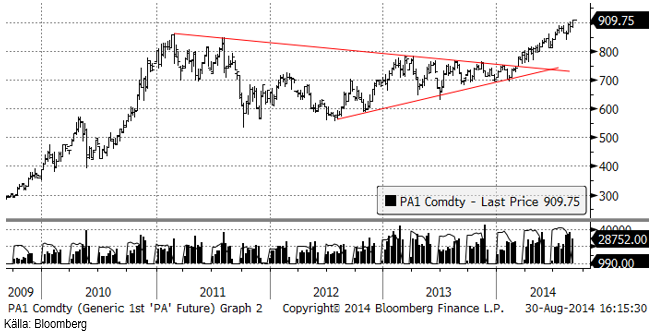
Nedanför ser vi hur mycket metall som finns i börshandlade fonder för platina respektive palladium. So vi ser har folk tagit hem sina vinster i båda den senaste veckan.
Vi är neutrala på platina men rekommenderar en köpt position i palladium.
Ris
Priset på ris (novemberkontraktet på CME) steg initialt men föll sedan tillbaka. Den statistik som kommit de senaste veckorna pekar på lägre skördar av ris i år. I veckan fick vi en sådan från Kina. Kinas tidiga risskörd minskade med 0.4% jämfört med förra året till 34 mt enligt National Bureau of Statistics i fredags.
Vi tycker inte att detta talar för ett fortsatt prisfall på ris, utan rekommenderar att man snarare investerar i RIS S.
Kaffe
Det är inga större nyheter på kaffefronten. Tekniskt ser vi att priset på decemberkontraktet tagit sig upp till 200 cent. Möjligen kommer priset att gå upp till 220 cent, där ett starkt motstånd finns. Fundamentalt ser vi dock inte något som talar för högre pris på kaffe.
Vi rekommenderar neutral position i kaffe.
Kakao
The International Cocoa Organization (”ICCO”) meddelade i fredags att 2013/14 kommer att ha ett produktionsöverskott på 40,000 ton och inte ett produktionsunderskott. Det beror på högre produktion än väntat i Elfenbenskusten. ICCO:s tidigare estimat var ett underskott på 75,000 ton. Marknadsföringsåret för kakao löper från den 1 oktober till 30 september.
Elfenbenskusten väntas enligt ICCO få en skörd på 1.73 mt (0.12 mt högre än tidigare väntat). Det innebär ett nytt rekord, i alla fall på papperet. Skörden 2010/11 kan ha varit högre, men det smugglades till grannländerna och skörden nu kan vara mindre, pga smuggling till Elfenbenskusten, enligt ICCO.
Även Ghana och Nigeria väntas få högre skördar, medan Kamerun och Ecuador får något lägre. Sammantaget gör ICCO en uppjustering av global produktion med 0.18 mt till 4.345 mt, vilket är ett nytt rekord. ICCO ser också att de afrikanska producenterna ökar sin produktionskapacitet och väntas fortsätta öka den 2014/15.
Globala lager ökar med 1.6 procentenheter till 38.9% av årlig konsumtion.
Spekulativ position ligger väldigt högt, historiskt sett.
Vi fortsätter med neutral position, men det börjar bli intressant att försöka sälja kakao om priset blir attraktivt. ”SHORT KAKAO A S” har en hävstång på -0.93 och kan vara ett lämpligt instrument att gå kort med.
För fler analyser på jordbruksråvaror se SEBs andra analysbrev.
[box]SEB Veckobrev Veckans råvarukommentar är producerat av SEB Merchant Banking och publiceras i samarbete och med tillstånd på Råvarumarknaden.se[/box]
Disclaimer
The information in this document has been compiled by SEB Merchant Banking, a division within Skandinaviska Enskilda Banken AB (publ) (“SEB”).
Opinions contained in this report represent the bank’s present opinion only and are subject to change without notice. All information contained in this report has been compiled in good faith from sources believed to be reliable. However, no representation or warranty, expressed or implied, is made with respect to the completeness or accuracy of its contents and the information is not to be relied upon as authoritative. Anyone considering taking actions based upon the content of this document is urged to base his or her investment decisions upon such investigations as he or she deems necessary. This document is being provided as information only, and no specific actions are being solicited as a result of it; to the extent permitted by law, no liability whatsoever is accepted for any direct or consequential loss arising from use of this document or its contents.
About SEB
SEB is a public company incorporated in Stockholm, Sweden, with limited liability. It is a participant at major Nordic and other European Regulated Markets and Multilateral Trading Facilities (as well as some non-European equivalent markets) for trading in financial instruments, such as markets operated by NASDAQ OMX, NYSE Euronext, London Stock Exchange, Deutsche Börse, Swiss Exchanges, Turquoise and Chi-X. SEB is authorized and regulated by Finansinspektionen in Sweden; it is authorized and subject to limited regulation by the Financial Services Authority for the conduct of designated investment business in the UK, and is subject to the provisions of relevant regulators in all other jurisdictions where SEB conducts operations. SEB Merchant Banking. All rights reserved.
Analys
Fear that retaliations will escalate but hopes that they are fading in magnitude

Brent crude spikes to USD 90.75/b before falling back as Iran plays it down. Brent crude fell sharply on Wednesday following fairly bearish US oil inventory data and yesterday it fell all the way to USD 86.09/b before a close of USD 87.11/b. Quite close to where Brent traded before the 1 April attack. This morning Brent spiked back up to USD 90.75/b (+4%) on news of Israeli retaliatory attack on Iran. Since then it has quickly fallen back to USD 88.2/b, up only 1.3% vs. ydy close.

The fear is that we are on an escalating tit-for-tat retaliatory path. Following explosions in Iran this morning the immediate fear was that we now are on a tit-for-tat escalating retaliatory path which in the could end up in an uncontrollable war where the US unwillingly is pulled into an armed conflict with Iran. Iran has however largely diffused this fear as it has played down the whole thing thus signalling that the risk for yet another leg higher in retaliatory strikes from Iran towards Israel appears low.
The hope is that the retaliatory strikes will be fading in magnitude and then fizzle out. What we can hope for is that the current tit-for-tat retaliatory strikes are fading in magnitude rather than rising in magnitude. Yes, Iran may retaliate to what Israel did this morning, but the hope if it does is that it is of fading magnitude rather than escalating magnitude.
Israel is playing with ”US house money”. What is very clear is that neither the US nor Iran want to end up in an armed conflict with each other. The US concern is that it involuntary is dragged backwards into such a conflict if Israel cannot control itself. As one US official put it: ”Israel is playing with (US) house money”. One can only imagine how US diplomatic phone lines currently are running red-hot with frenetic diplomatic efforts to try to defuse the situation.
It will likely go well as neither the US nor Iran wants to end up in a military conflict with each other. The underlying position is that both the US and Iran seems to detest the though of getting involved in a direct military conflict with each other and that the US is doing its utmost to hold back Israel. This is probably going a long way to convince the market that this situation is not going to fully blow up.
The oil market is nonetheless concerned as there is too much oil supply at stake. The oil market is however still naturally concerned and uncomfortable about the whole situation as there is so much oil supply at stake if the situation actually did blow up. Reports of traders buying far out of the money call options is a witness of that.
Analys
Fundamentals trump geopolitical tensions

Throughout this week, the Brent Crude price has experienced a decline of USD 3 per barrel, despite ongoing turmoil in the Middle East. Price fluctuations have ranged from highs of USD 91 per barrel at the beginning of the week to lows of USD 87 per barrel as of yesterday evening.

Following the release of yesterday’s US inventory report, Brent Crude once again demonstrated resilience against broader macroeconomic concerns, instead focusing on underlying market fundamentals.
Nevertheless, the recent drop in prices may come as somewhat surprising given the array of conflicting signals observed. Despite an increase in US inventories—a typically bearish indicator—we’ve also witnessed escalating tensions in the Middle East, coupled with the reinstatement of US sanctions on Venezuela. Furthermore, there are indications of impending sanctions on Iran in response to the recent attack on Israel.
Treasury Secretary Janet Yellen has indicated that new sanctions targeting Iran, particularly aimed at restricting its oil exports, could be announced as early as this week. As previously highlighted, we maintain the view that Iran’s oil exports remain vulnerable even without further escalation of the conflict. It appears that Israel is exerting pressure on its ally, the US, to impose stricter sanctions on Iran, an action that is unfolding before our eyes.
Iran’s current oil production stands at close to 3.2 million barrels per day. Considering additional condensate production of about 0.8 million barrels per day and subtracting domestic demand of roughly 1.8 million barrels per day, the net export of Iranian crude and condensate is approximately 2.2 million barrels per day.
However, the uncertainty surrounding the enforcement of such sanctions casts doubt on the likelihood of a complete ending of Iranian exports. Approximately 80% of Iran’s exports are directed to independent refineries in China, suggesting that US sanctions may have limited efficacy unless China complies. The prospect of China resisting US pressure on its oil imports from Iran poses a significant challenge to US sanctions enforcement efforts.
Furthermore, any shortfall resulting from sanctions could potentially be offset by other OPEC nations with spare capacity. Saudi Arabia and the UAE, for instance, can collectively produce an additional almost 3 million barrels of oil per day, although this remains a contingency measure.
In addition to developments related to Iran, the Biden administration has re-imposed restrictions on Venezuelan oil, marking the end of a six-month reprieve. This move is expected to impact flows from the South American nation.
Meanwhile, US crude inventories (excluding SPR holdings) surged by 2.7 million barrels last week (page 11 attached), reaching their highest level since June of last year. This increase coincided with a decline in measures of fuel demand (page 14 attached), underscoring a slightly weaker US market.
In summary, while geopolitical tensions persist and new rounds of sanctions are imposed, our market outlook remains intact. We maintain our forecast of an average Brent Crude price of USD 85 per barrel for the year 2024. In the short term, however, prices are expected to hover around the USD 90 per barrel mark as they navigate through geopolitical uncertainties and fundamental factors.
Analys
Brace for Covert Conflict

In the past two trading days, Brent Crude prices have fluctuated between highs of USD 92.2 per barrel and lows of USD 88.7 per barrel. Despite escalation tensions in the Middle East, oil prices have remained relatively stable over the past 24 hours. The recent barrage of rockets and drones in the region hasn’t significantly affected market sentiment regarding potential disruptions to oil supply. The key concern now is how Israel will respond: will it choose a strong retaliation to assert deterrence, risking wider regional instability, or will it revert to targeted strikes on Iran’s proxies in Lebanon, Syria, Yemen, and Iraq? While it’s too early to predict, one thing is clear: brace for increased volatility, uncertainty, and speculation.

Amidst these developments, the market continues to focus on current fundamentals rather than unfolding geopolitical risks. Despite Iran’s recent attack on Israel, oil prices have slid, reflecting a sideways or slightly bearish sentiment. This morning, oil prices stand at USD 90 per barrel, down 2.5% from Friday’s highs.
The attack
Iran’s launch of over 300 rockets and drones toward Israel marks the first direct assault from Iranian territory since 1991. However, the attack, announced well in advance, resulted in minimal damage as Israeli and allied forces intercepted nearly all projectiles. Hence, the damage inflicted was limited. The incident has prompted US President Joe Biden to urge Israel to exercise restraint, as part of broader efforts to de-escalate tensions in the Middle East.
Israel’s response remains uncertain as its war cabinet deliberates on potential courses of action. While the necessity of a response is acknowledged, the timing and magnitude remain undecided.
The attack was allegedly in retaliation for an Israeli airstrike on Iran’s consulate in Damascus, resulting in significant casualties, including a senior leader in the Islamic Revolutionary Guard Corps’ elite Quds Force. It’s notable that this marks the first direct targeting of Israel from Iranian territory, setting the stage for heightened tensions between the two nations.
Despite the scale of the attack, the vast majority of Iranian projectiles were intercepted before reaching Israeli territory. However, a small number did land, causing minor damage to a military base in the southern region.
President Biden swiftly condemned Iran’s actions and pledged to coordinate a diplomatic response with leaders from the G7 nations. The US military’s rapid repositioning of assets in the region underscores the seriousness of the situation.
Iran’s willingness to escalate tensions further depends on Israel’s response, as indicated by General Mohammad Bagheri, chief of staff of the Iranian armed forces. Meanwhile, speculation about a retaliatory attack from Israel persists.
Looking ahead, key questions remain unanswered. Will Iran launch additional attacks? How will Israel respond, and what implications will it have for the region? Moreover, how will Iran’s allies react to the escalating tensions?
Given the potential for a full-scale war between Iran and Israel, concerns about its impact on global energy markets are growing. Both the United States and China have strong incentives to reduce tensions in the region, given the destabilizing effects of a regional conflict.
Our view in conclusion
The recent escalation between Iran and Israel underscores the delicate balance of power in the volatile Middle East. With tensions reaching unprecedented levels and the specter of further escalation looming, the potential for a full-blown conflict cannot be understated. The ramifications of such a scenario would be far-reaching and could have significant implications for regional stability and global security.
Turning to the oil market, there has been much speculation about the possibility of a full-scale blockade of the Strait of Hormuz in the event of further escalation. However, at present, such a scenario remains highly speculative. Nonetheless, it is crucial to note that Iran’s oil production and exports remain at risk even without further escalation. Currently producing close to 3.2 million barrels per day, Iran has significantly increased its production from mid-2020 levels of 1.9 million barrels per day.
In response to the recent attack, Israel may exert pressure on its ally, the US, to impose stricter sanctions on Iran. The enforcement of such sanctions, particularly on Iranian oil exports, could result in a loss of anywhere between 0.5 million to 1 million barrels per day of oil supply. This would likely keep the oil market in deficit for the remainder of the year, contradicting the Biden administration’s wish to maintain oil and gasoline prices at sustainable levels ahead of the election. While other OPEC nations have spare capacity, utilizing it would tighten the global oil market even further. Saudi Arabia and the UAE, for example, could collectively produce an additional almost 3 million barrels of oil per day if necessary.
Furthermore, both Iran and the US have expressed a desire to prevent further escalation. However, much depends on Israel’s response to the recent barrage of rockets. While Israel has historically refrained from responding violently to attacks (1991), the situation remains fluid. If Israel chooses not to respond forcefully, the US may be compelled to promise stronger enforcement of sanctions on Iranian oil exports. Consequently, Iranian oil exports are at risk, regardless of whether a wider confrontation ensues in the Middle East.
Analyzing the potential impact, approximately 2.2 million barrels per day of net Iranian crude and condensate exports could be at risk, factoring in Iranian domestic demand and condensate production. The effectiveness of US sanctions enforcement, however, remains uncertain, especially considering China’s stance on Iranian oil imports.
Despite these uncertainties, the market outlook remains cautiously optimistic for now, with Brent Crude expected to hover around the USD 90 per barrel mark in the near term. Navigating through geopolitical tensions and fundamental factors, the oil market continues to adapt to evolving conflicts in the Middle East and beyond.
-

 Nyheter2 veckor sedan
Nyheter2 veckor sedanGuldpriset når nytt all time high och bryter igenom 2300 USD
-

 Nyheter3 veckor sedan
Nyheter3 veckor sedanLundin Mining får köprekommendation av BMO
-

 Nyheter4 veckor sedan
Nyheter4 veckor sedanVertikal prisuppgång på kakao – priset toppar nu 9000 USD
-

 Nyheter2 veckor sedan
Nyheter2 veckor sedanCentralbanker fortsatte att köpa guld under februari
-

 Nyheter4 veckor sedan
Nyheter4 veckor sedanKaffepriserna stiger på lågt utbud och stark efterfrågan
-

 Nyheter2 veckor sedan
Nyheter2 veckor sedanHur mår den svenska skogsbraschen? Två favoritaktier
-

 Nyheter3 veckor sedan
Nyheter3 veckor sedanBoliden på 20 minuter
-

 Nyheter2 veckor sedan
Nyheter2 veckor sedanKakaomarknaden är extrem för tillfället


